|
THE WALMER BREWERY 1816-1978
(Part One: 'Bread, beer and 'baccy')
Blatantly plagiarised from Bygone Kent. Volume 24. Number 10. October 2003.
By David G. Collyer
Introduction
One of my favourite quotations when introducing a local history walk or talk
on Deal's past is that 'our town was founded on 'bread, beer and 'baccy' -
with seven mills grinding flour, four breweries to supply beer, although
most of the 'baccy' would have been smuggled across from the Continent. Deal
had been the site of a naval stores yard almost as long as it had boasted
three castles to defend the coast against an invasion at the time Henry VIII
wished to obtain his divorce. Three breweries have been recorded in 'Lower
Deal', while that which was to survive the longest was in Walmer, atop the
hill alongside the old turnpike road to Dover.
As a limb of Sandwich under the Confederation of the Cinque Ports, Deal was
amongst those towns which supplied beer to King Henry V during his
continental expedition of 1415, and such was the fame of one particular ale
that the diarist Samuel Pepys even made a special trip ashore when aboard a
vessel anchored in the Downs to the town to sample it:
'Apr 30th 1660 Mr Howe, Mr Sheply, and I got my Lord's leave to go to see Capt Sparling. So we took boat, and first went on shore, it being very
pleasant in the fields; but what a pitiful town Deal is. We went to Fuller's
(the famous place for ale), but they have none but what is in the vat. After
that to Poole's, a tavern in the town, where we drank, and so to boat
again.'
With the increasing numbers of seamen coming ashore when Royal Navy vessels
were anchored in The Downs, the Lords of the Admiralty wrote to the Lord
Warden on at least one occasion requesting that local innkeepers not supply
seamen drinks on credit 'because they spend their money, run up credit and
then abscond'. The request that only 'genuine shipwrecked mariners' be given
credit could have easily been circumnavigated by getting themselves
thoroughly soaked while being rowed ashore.
Founding of Walmer Brewery
The intense activity and large numbers of personnel, both naval and
military, passing through Deal and Walmer during the turn of the nineteenth
century led to great prosperity for suppliers of stores and equipment to HM
forces. Many fortunes were made, and some subsequently lost, when the
Napoleonic Wars ended and the town fell on hard times. On a map of 1810
there appears to be a 'brewery' marked
behind the Dolphin public house at the northern end of North Barracks Road.
However, no trace of it now remains.
|
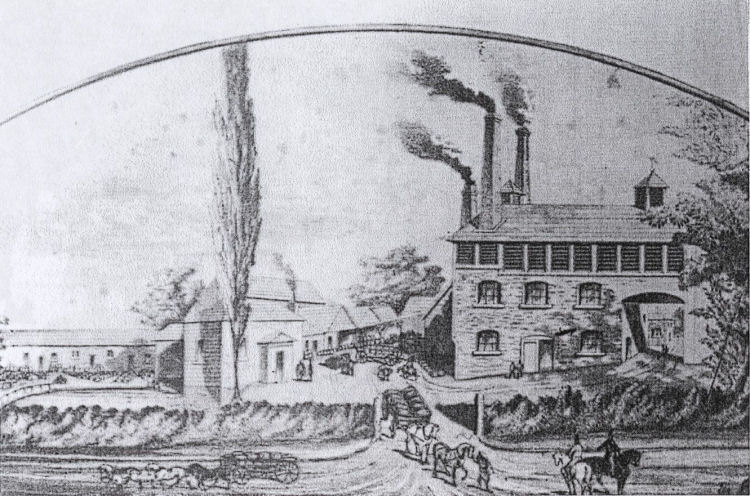
The Walmer Brewery as it was originally built, before the extensions
erected by Mr Edmund Thompson in 1826. The main brewhouse and ancillary
buildings could still be identified after this time.
(Via Win Barrow) |
|
It is said that a Captain Richard Thompson had attacked a Spanish
galleon, taking the crew prisoner. The wretched crewmen were later ransomed
and the fortune Thompson thus acquired was used to found the brewery. In
1816 Edmund Thompson was one who sought to take advantage of this increasing
trade, and at that time there were Thompsons living in Duke Street, Lower
Deal, a road named after one of the two 'Hayman' brothers whose brewery had
been on this site. Whether Mr Thompson was a former employee of the Haymans,
one can only speculate, but he started the business which was to flourish
for the succeeding 150 years.
Unfortunately, the early records of Messrs Thompson & Son were lost in an
office fire in 1820, so much of the early history of the brewery must be
speculation, as stated by the authors of 'The Deal and Walmer Illustrated
Guide' published in 1897:
'Although there is no evidence of this brewery having been in
existence prior to the date mentioned, we cannot but think that Walmer must
have boasted a similar establishment, on a smaller scale, at some anterior
period, and that Mr Thompson's more important organisation was designed to
replace and enlarge upon the latter.
'The brewery buildings cover a large area of ground in the picturesque
village of Upper Walmer. They are approached from the main Dover Road by
means of a wide gateway, with public and private offices on the left; and
the entire range of premises, mostly of quite modern construction, has been
admirably planned throughout; strict cleanliness and good order being
distinctly observable features in each spacious department. Plant and
appliance, too, even to the smallest minor details are of the latest
improved kinds, and necessarily equal to an extremely large regular
turn-out. In fact, the firm's well known trade mark, the South Foreland
Lighthouse, on either bottled or draught ales or stout, may always be looked
upon as a distinct guarantee of purity and excellence.'
As with the other East Kent breweries e.g. Gardener's of Ash; Cobb's of
Margate; Thomson & Wooton of Ramsgate, Mackeson's of Hythe and Leney's of
Dover, Thompson & Sons had their distinctive range of ales and stout; unlike
the homogenised, standardised and gasified products which are on sale today!
The authors of the Illustrated Guide continued to sing their praises:
'The A.K.S. Bitter Ale will be found a particularly well flavoured
tonic ale for general use; whilst the A.K. cheaper ale, and the celebrated
India Pale Ale are both of excellent quality, clear and bright to the last.
The latter as well as Pale Ale, Light Dinner Ale, Stout and Cooper are also
obtainable in fine condition in screw topped bottles. The other productions
of the Walmer Brewery consist of X, XX and XXX Ales of varying strengths,
Double Stout and Porter; whilst the firm also bottle large quantities of
Bass's Ales in the best possible condition.'
The improvements mentioned above had taken place since 1867, under the
management of Mr John Matthews, formerly the senior partner in Matthews and
Canning of The Anchor Brewery, Chelsea, who had had the new maltings built.
By 1897 the brewery was under the management of Mr Arthur J. and Mr William
P. Matthews who had succeeded him. The drawing reproduced in the Deal &
Walmer Guide shows the old brewery with its tall chimney to the right, with
stables and dray shed in front. The 'maltings' appear in the centre, with a
covered way between the bottling department, company offices, oast houses,
etc on the left. As is usual with these artist's impressions, the buildings
are increased in size according to their importance, whilst any figures,
horses or vehicles are diminished in scale. Two years later Messrs Thompson
& Sons had acquired the only other similar establishment in the area, that
of Messrs Hills of Deal and Great Mongeham. Their brewing operations were
then both transferred to Walmer, while their 'tied houses' were also taken
over and added to those already owned by Thompson's. In the 'Health Resorts
Guide' to Deal and Walmer published in 1914, Messrs Thompson & Sons were
advertising beer in the bottle, direct to the public, and a crate containing
four quarts of light ale costing one shilling and four pence. A 36-gallon
cask of light ale was priced at 36 shillings - a shilling a gallon!
|
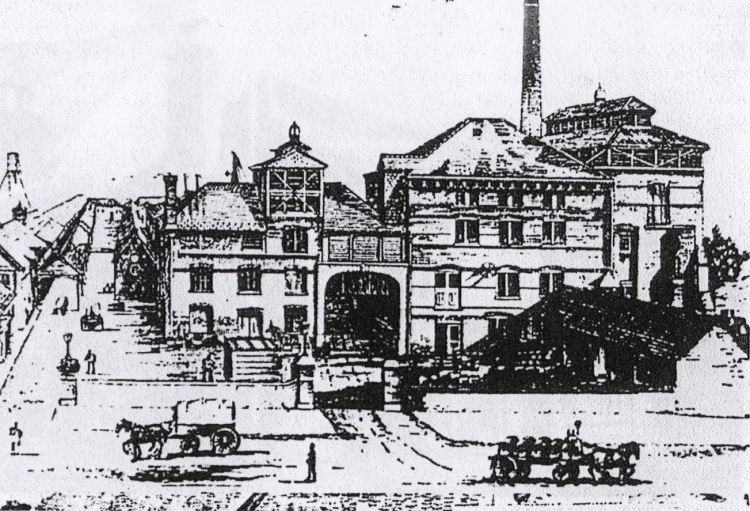
Sketch of Thompson & Sons' Walmer Brewery from the 'Illustrated Guide to
Deal and Walmer' published in 1897. The scale of the figures, drays, etc in
the drawing have been deliberately minimised to emphasise the importance of
the buildings. (Via Ken Weston) and below a photograph of the same site from
almost the same position, date unknown.
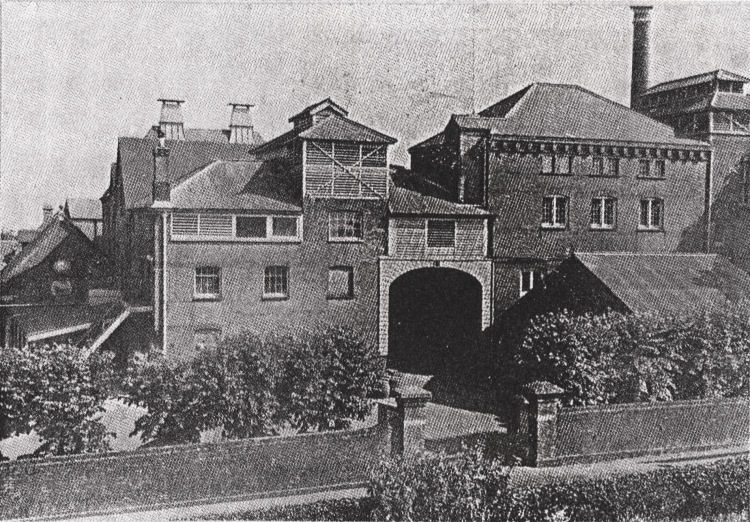
|
|
The Brewery in World War One
When the First World war broke out Army mules were housed in the former
brewery stables, which would regularly get out '(or were let out by
children) and went trotting off down the road, and had to be rounded up'
(Mrs Ivy Harrison). The stables had been erected for the heavy 'draught'
horses employed by the brewery as traditionally beer had been delivered by
horse-drawn carts known as 'drays' which can still occasionally be seen at
events such as the Kent Agricultural Show, at Whitbread's Beltring Hop Farm
or in the Lord Mayor's Show (from Young's of Wandsworth). However, in 1912
Messrs Thompson & Sons had acquired a Sentinel steam wagon for deliveries to
their outlying 'tied houses', and when horses had been 'requisitioned' by
the Army in 1916 they acquired another similar vehicle. This would be driven
by Mr Ernest Amos who, together with his crew of 'Stevo' Ladd and 'Digger'
Edmedes, went as far as The Clifton Baths, Margate, to deliver beer.
Ernest's son, Fred recalled: 'I was at Ringwould school at the time, and
when they delivered beer to Dover my father used to come by our house and we
would jump up on the back to get a ride to school'. When these were replaced
post-war with motor lorries there were no drivers qualified to handle them.
However, help was at hand as the proprietor of the local garage in Station
Road had learned to drive on motor lorries during the war, and it was he who
gave the 'steam drivers' their conversion course. 'Tom Finnes was the first
employee to learn to drive them, followed by my Uncle Harvey, and this would
have been about 1930/31' remembered Mrs V.M. Hostie.
|
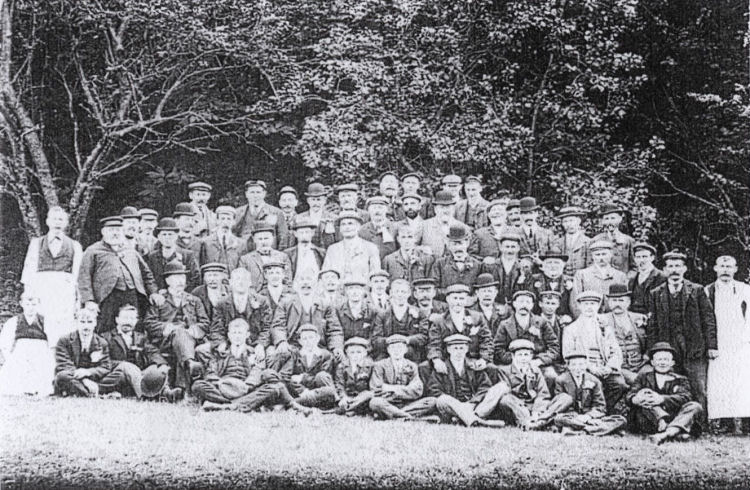
Thompson & Son's brewery workers circa 1890 showing that then employees
would have been exclusively male prior to World War One. This was probably
taken on one of the firm's annual outings when the brewery boilers were
being serviced?
(Via Mrs O. Harrison) |
|
Between the World Wars
Another youngster who was growing up during the 1920s was Dick Game, whose
father was the Head Brewer or manager at Thompson's Brewery.
'In the 1920s the whole of Upper Walmer was influenced by the Brewery. The
smell of beer pervaded the whole area and its tall chimney was visible for
miles. Employing seventy people, who in turn supported the shops and local
businesses, the brewery never closed, although work stopped on the whistle.
'We lived at King's Cottage, the last house on the left of Dover Road going
towards Ringwould, surrounded by a grass field and farm buildings. This was
a brewery house; five bed, three recep, gas lighting and cooking. No
telephone, electricity, central heating, or car - but a big garden. Almost
opposite lived Mr Gurr, head gardener to Mr Willie Matthews. Opposite the
brewery were a few terraced houses, the end one being occupied by Major
George Matthews and his wife. They gave good children's Christmas parties
and Mr Taylor, the company secretary and his wife and three grown-up
daughters lived next door.
'The Brewery traveller and salesman (known in those days as 'The Outside')
was Mr Bert Dredge who lived with his wife, daughter and son at a
three-storey house on the corner of Church Street. They, too, gave good
children's parties. There was also a Christmas party at "The Shrubbery"
(very best behaviour) and a summer party at "The Old House".
'As you went through the main gates of the Brewery, on the right was the
cask washing. Hot water and steam, men in clogs and leather aprons washing
our Hogsheads (51½ gallons), Barrels (35 gallons), Kilderkins
(18 gallons), Firkins (9 gallons) and Pins (4½ gallons). On the left was the office, a single storey
building with big
windows, while behind that was the bottle store, where the women worked and
machines filled bottles with different beers, and then labelled them.
'My father would walk across a grass field and enter by a private back gate
by the malt house; a long low building with small shuttered windows. In
there men with wooden shovels turned the sprouting barley. Father's office
was three storeys up in the main building, approached by a long wooden
outside staircase, but also through an inside door. My father always wore a
suit with a waistcoat, a shirt with stiff collar and a gold watch and chain.
While in the Brewery he wore a long white coat (like a doctor does today)
but when outside he adopted a Homburg hat like Edward VII, and he also wore
spats in the winter.'
As the one main employer in the village, the owners of the brewery held an
over-whelming influence over the lives of their workers ...
'Whenever there was a General Election the brewery was decorated with the
local Conservative Party colours - orange and purple for Hon. J.J. Astor,
the local candidate. Whatever your opinion, no one dare oppose the Matthews,
or your job and house were risked because there was widespread depression
and much unemployment.' (Dick Game)
|
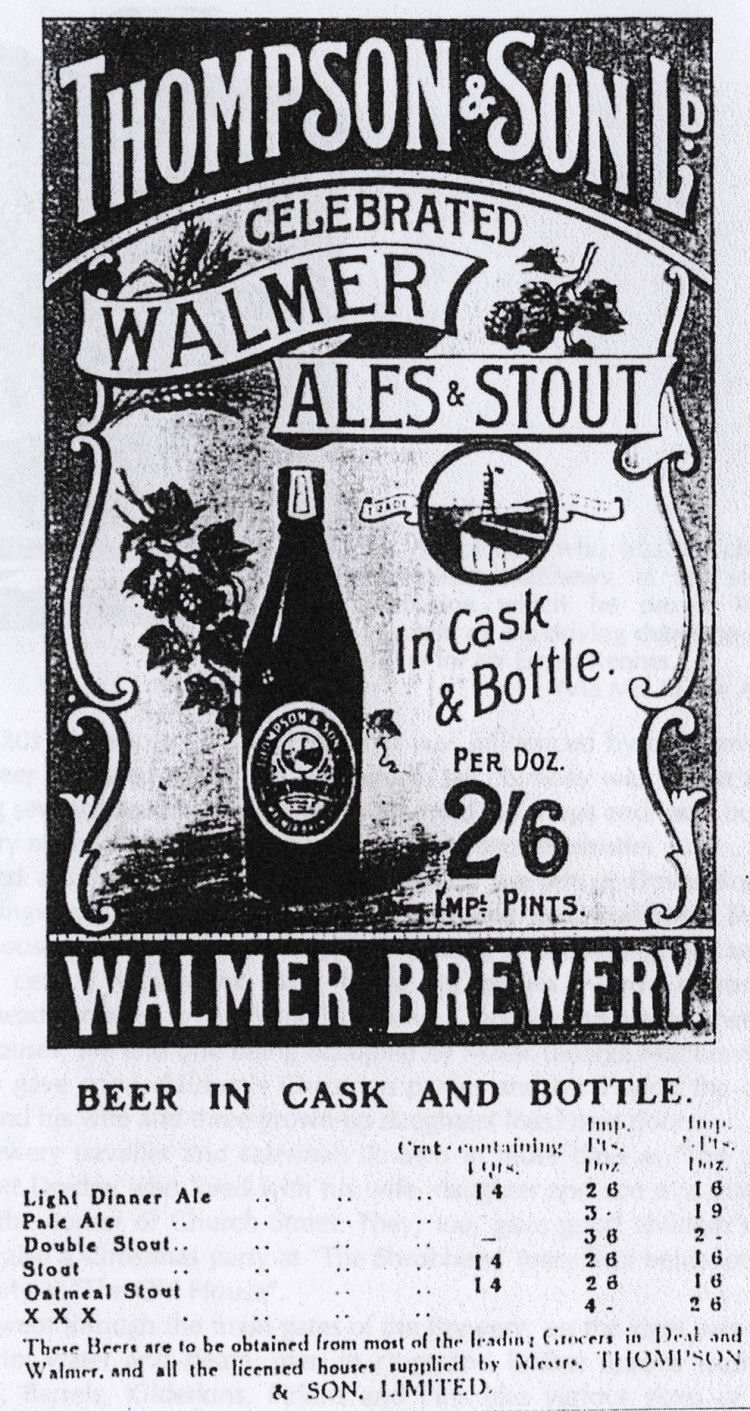
This advertisement for the celebrated ales and stouts of Thompson & Sons Ltd
appeared in the 1914 edition of 'The Deal Guide', published by the Health
Resorts Association! |
|
The Old House
For a businessman there is nothing like living near to the job, and one
member of the Matthews' family occupied a house opposite the brewery in
Dover Road, recalls Mrs V.M. Hostie:
'I was born in Dover Road, Upper Walmer, in 1923, and during my childhood
and up to the Second World War Mr and Mrs 'Willie' Matthews occupied the
'Old House', where there is now the Thompson Close estate. Mr and Mrs Arthur
Matthews and their daughter, Miss Eileen Matthews, lived in "The Shrubbery"
in Dover Road. Their estate ran from Church Path to Glebe House, and through
to St Mary's Church. Mr Willie and Mr Arthur Matthews were brothers.'
Mrs Audrey West, the granddaughter of the company secretary Mr Taylor,
recalls visiting 'The Old House' with her aunt when she attended the playing
of string quartets, as the Matthews family were all very musical.
|
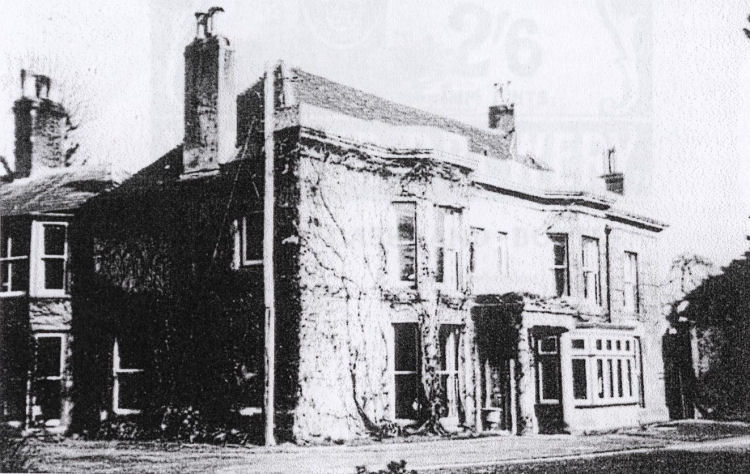
'The Old House', the home of director Mr Willie Matthews, which stood on the
opposite side of Dover Road to the Brewery. Demolished in the 1960s, the
site is now occupied by a cul-de-sac that has been named 'Thompson's Close'.
(Via Mrs Maureen Over) |
|
'Mr Willie Matthews played the cello; his wife the violin, my aunt also
played the violin and a lady from Kingsdown played the viola. There was a
large grass tennis court behind the house, and a hay field where there used
to be "hay parties" when all their employees turned-out to get the cut hay
in, then sat down to a feast afterwards. Mr Arthur Matthews used to hold
"hay parties" at "The Shrubbery" as well.'
'Both Mr Willie and Mr Arthur Matthews owned large cars and employed
chauffeurs. Mr Arthur Rye was chauffeur to "Willie" Matthews and drove one
of the limousines where the driver was separated from the passengers by a
glass screen.' He was also a taxi driver for Mr Ernest Kennett at The Green
Garage, Station Road, Upper Walmer (see 'Bygone Kent' Volume 13 Number 6).
|
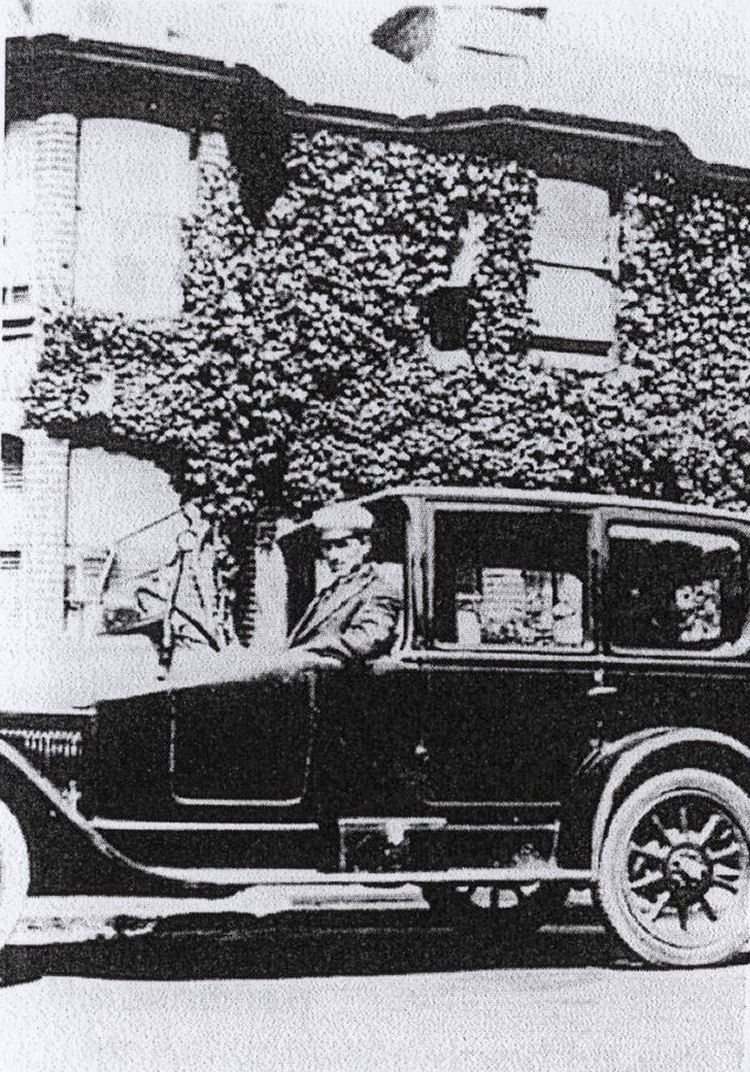
Mr Arthur Rye, who was the chauffeur to Mr Willie Matthews, at the seat of
the limousine which he drove. When not engaged on his driving duties he was
a taxi driver for Mr Ernest Kennel.
(Via Mrs Renee Appleton) |
|
The Shrubbery
Mr Arthur Matthews and his wife lived at 'The Shrubbery', a large house
which stood on the site of an older property once occupied by Princess
Amelia, one of William IV's daughters. This stood next to the 'Convent of
the Visitation' a little further down the Dover Road towards Deal from the
brewery.
'The servants were not trusted, so when the Matthews family went away Mrs
Matthews would put a lock on the oven to prevent them using it. She is also
remembered as driving her carriage, with two black horses, out of the
driveway into Dover Road. There was a mirror placed on the gatepost so that
any vehicles approaching around the bend could be seen before the carriage
emerged into the roadway.'
|
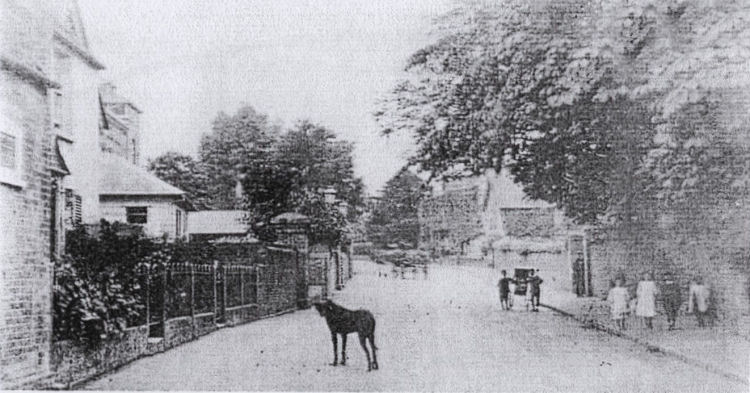
Dover Road, Upper Walmer, showing Thompson's Brewery on the left, the garden
wall of 'The Old House' on the right and other properties occupied by
employees of the firm.
(Via Win Barrow) |
|
Codicil
Miss Harriet Cooke was an elderly lady who lived in a little cottage on the
opposite side of Dover Road to 'The Shrubbery'. Mr Arthur Matthews felt
sorry for this 'poor old lady' and so on Sundays he would pop over the road
with a plate of roast dinner for her. When she died Miss Cooke appointed Mr
Matthews her executor and left him her estate, which proved to be
sufficiently large to enable a row of almshouses to be erected and endowed,
and which still exist and carry
'poor' Miss Cookes name to this day.
Acknowledgements
Mr Dick Game, Mrs Maureen Over, Mrs Win Barrow, Mr Roger Saunders; Mr Peter
Finnis; Mr Terry Williams; 'The Illustrated Guide to Deal & Walmer' (1897);
'Walmer Brewery Handbook' (1950); 'To by Times', Charrington & Co. (1954).
THE WALMER BREWERY 1816-1978
(Part Two: 'Bright and airy buildings, lit by
smiling faces')
By David G. Collyer
The Second World War
Being situated on the rising ground alongside the Dover Road, Walmer Brewery
was in an ideal situation to aid the defence of the village against invasion
in the summer of 1940. Behind the wall of the garden of 'The Old House' and
the brewery yard was installed a 'Defile Flame Trap' (see 'Bygone Kent'
Volume 13 Number 9). The fuel pumps and pipe work were in place by the
Spring of 1941 when a local AFS fireman Mr Stuart Harlow recalls helping
test the installation:
'I did see this tested once, the pipes ran along the outside of the brewery
wall, and there were tanks of petrol and a pump so that petrol could be
sprayed onto the road. For the test we had a Brigadier, a Colonel and a
Major present and when the pumps were turned on petrol was sprayed onto the
roadway and started to run down the road. One of the soldiers set it alight
by throwing a Molotov Cocktail onto the road.
'Although the flames didn't damage the roadway too much, they set alight a
nearby garden hedge, which fortunately we managed to extinguish. After the
test had ended, the Brigadier came up and congratulated us on our good work
and also gave the Leading Fireman a £1.00 note "to get the lads a drink".'
With the brewery being situated on nearly the highest part of Upper Walmer,
it was vulnerable to attack by the fighter-bombers on 'Hit & Run' raids
across the Channel. With constant air raid alerts interrupting production,
such premises had a 'roof spotter' positioned on the look out to warn of any
imminent attack. A cool head for heights and good aircraft recognition
skills were essential, and one of those employed at Thompson's Brewery was
Peter Finnis:
'In May 1942 I joined the Air Training Corps No. 1458 (Deal) Squadron, that
was to train us for the RAF. Some lads trained as pilots, I trained as a
Wireless Operator/Air Gunner. As an Air Gunner, aircraft recognition was
high in our training, and just before my sixteenth birthday, I was
approached by a friend who was going into the Forces; he asked me if I would
like to take on his job as 'roof spotter' at the Walmer Brewery.
'The look out post was on top of an oast house, the top of which had been
removed and a three-quarter flat roof had been substituted for the cowl, so
that it could be turned round to keep out the rain, snow, etc. Myself and
another lad
went up the long ladders to get to our look out, where we duly remained on
duty from 8.00 a.m. to 6.00 p.m. We took sandwiches and a flask, and only
left our post for the "call of nature". Our duties were to keep a sharp look
out for enemy aircraft approaching Deal, or when the Germans started to fire
their long-range guns across the Channel. If they were getting too close, we
had to warn the brewery staff.
'We used a bell system for warning the staff. If there were enemy planes
about, or the shelling had started but there was no immediate danger we
would give four short rings. The staff would then carry on working, but
would be prepared to take cover. When we thought that the shelling was
getting close, or the enemy aircraft were heading towards us, we would give
four long rings; for the "All Clear" it would just be one long ring.
'We often saw the Germans bombing or shelling our convoys going through the
Dover Straits, as we had a very good view of the Channel from our look out
and on a clear day we could see the clock tower in Calais. The brewery was
lucky, as it wasn't hit by bombs or shells, although the look out was fired
on by a passing Messerschmitt Bf109E fighter - luckily he fired in a hurry
and his bullets went about two feet above us, and we could see the marks of
the bullets on the chimney stack behind us.'
'The summer days were lovely, but the winter was very cold, and try as we
might, we could not keep the draughts from blowing through the gaps in the
floor boards. This is the only time that I have worn "Long johns". We were
proud of the fact that we never once left our post.'
|
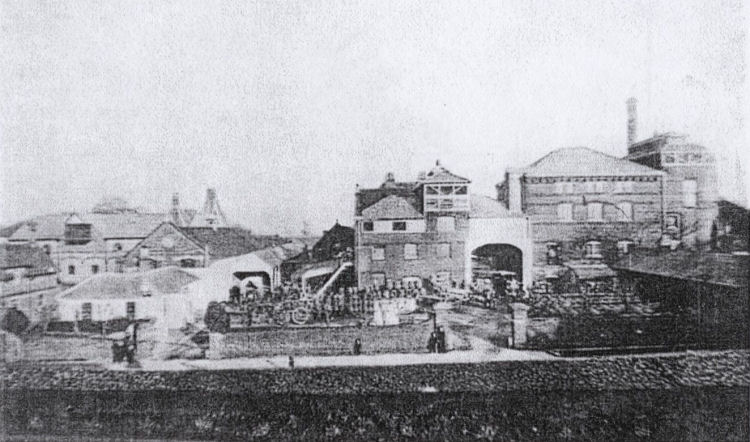
This view of Thompson & Son's Walmer Brewery must have been taken from an
attic window of 'The Old House' which once stood opposite. Left to right are
the cask washing, maltings, brew house, bottling department and the stables.
(Photo via Win Barrow) |
|
After the war had ended the brewery resumed peace-time operations once again
as former employees who had been 'called-up' or who had volunteered for HM
Forces returned to work. The former home of Mr 'Willie' Matthews had been
vacated during the war, and was now taken over as the brewery offices, apart
from one wing, as Mrs Maureen Over recalls:
'I lived at "The Old House" from 1946/7 until 1950, and my name was then
Maureen Anderson. We lived in the right hand wing of the house, as you face
it from the road, the rest of the building housed brewery offices. It was a
lovely house with really beautiful gardens which stretched down to the
Walmer-Martin Mill railway line. At that time a full-time gardener was
employed named Frank Gurr, who lived somewhere close by, in one of the tied
cottages on the opposite side of Dover Road.
'As I recall there were entrance gates each end of the old wall (which is
still there), and a semi-circular drive to the front entrance. The main door
was central in front of the house, and there were large bay windows to the
rooms on either side. The whole frontage was then covered with a beautiful
mauve wisteria, and it was quite a picture in the Spring. Our wing was at
the right hand side of the frontage, and was, I imagine, originally the
servants' quarters, as there were cellars beneath.'
When men had been called-up for wartime service, women had replaced them,
and they continued to be employed post war. These 'girls' as they were
referred to (however old they were) were very popular with the local lads,
as Mr Terry Williams who was then one of the recruits under training at the
Royal Marines School of Music, explains. 'If you should be going out with
one of the "brewery girls", an added bonus was that they all got a "beer
allowance" as part of their wages.' Winifred Delahaye was one of Thompson's
'brewery girls', who lived in Mill Road, Deal, and thus had a long journey
to work at the top of Drum Hill.
'I worked in the bottling department of the Walmer Brewery from 1947 until
the works were closed in 1963. The machinery we used was so ancient, it
might almost have been the original installation. It was always going wrong,
and then a mechanic would be called in to fix it, and that's how I met and
eventually married my husband Jack.
'As I became more experienced, I was then promoted to be a "Key Hand" and
wore an embroidered key on my overall, as all the girls had to wear these
and also hats. Two years before I left I finally was promoted to forewoman.
In my day Mr R C Gray was the Master Brewer, Ron Latham worked in the office and
"Johnny" Alcock was the Brewery Manager, and lived in the house on the
corner of Church Street and Dover Road. He was later moved into the ground
floor of "The Old House", where we had a maisonette at the end, but we only
lived there between 1958 and 1960, when it was sold. Before that, we had
spent some four years living with my mother.'
|
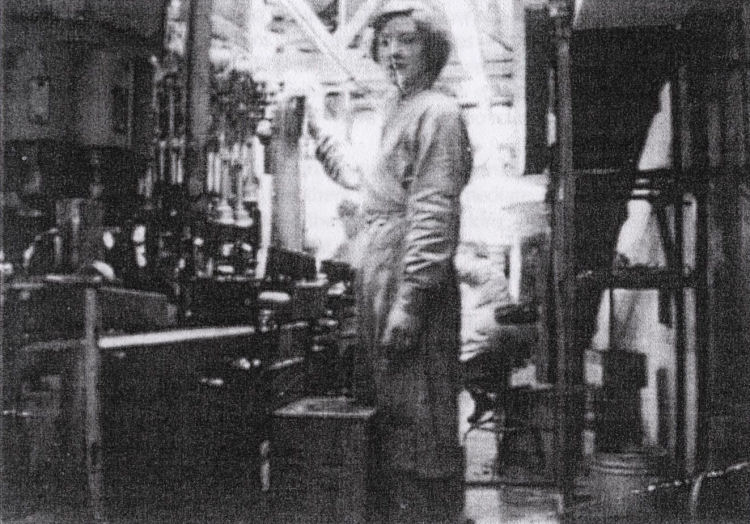
Miss Winifred Delahaye operating some of the antiquated bottling plant
machinery before it was replaced just prior to Messrs Charrington & Coo's
acquisition of the Walmer Brewery in 1951.
(Photo via Win Barrow) |
|
The Charrington Era
In 1951 Thompson & Sons was taken over by the then owners of the Mile End
Brewery as part of their expansion, which also included the Kemp Town
Brewery, Brighton. Their best remembered product being 'Toby Ale', their
house magazine was titled 'The Toby Times' and in 1954 it carried an article
promoting the delights of working 'by the seaside'; an early example of
'London overspill'. The ancient equipment in the bottling plant had been
replaced in the latter years of Thompson & Son's ownership, and in an
attempt to encourage the migration of Charrington's London-based workers to
Walmer, their existing workforce (consisting by then of just a couple of
dozen girls) were said to enjoy:
' ... bright and airy buildings, lit by smiling faces. The buildings are
only five minutes from the sea and a short bus ride from Deal. A few whiffs
of ozone are enough to dispel that tired feeling at the end of the hardest
day, and although Walmer is not protected from the north winds like
Brighton, the bottling machines work just as fast.
|
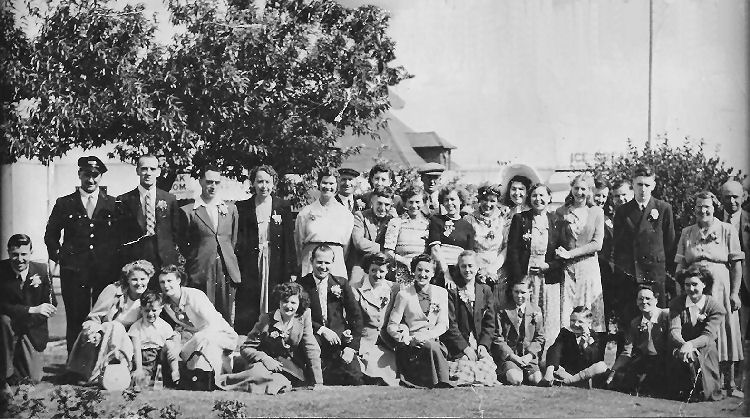
A Walmer Brewery outing in the 1950s, after the brewery had been reduced to
a bottling and storage facility. Note the predominance of young ladies, as
compared with the 1890 photograph in Part One.
(Photo via Win Barrow)
Further information from Terry Cooper says:- My Mum, Ann Cooper (Wynne)
is front row fifth from left. Her friend Joyce Lee (Moore) is middle row 8th
from left, she is still alive. (Sept 2014.) On the back of the photo my mum
had written 'Me, my pals 4/7/1950 at London'.
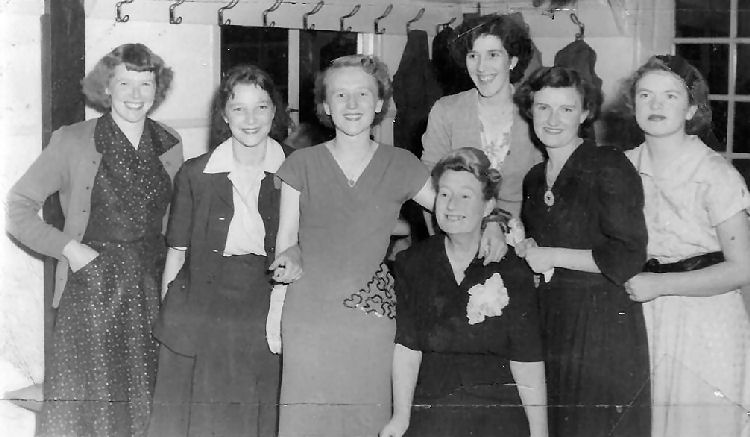
Information again from Terry Cooper:- My Mum, Ann Cooper, is on the right
and third from left is Kath Smith (Watkins). Kath Smith's relation said it
was a group from the brewery.
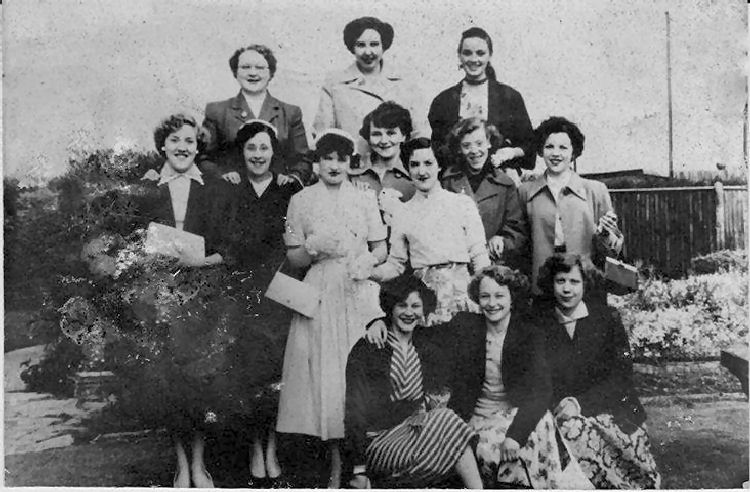
Above photo, from Terry Cooper:- My Mum, Ann is middle row, third from
left (wearing white dress and white handbag). Back row left is Gladys Bond (Vallence).
Her relatives said it was a brewery photo probably taken in 1960. |
|
'The offices are set in large gardens which are the pride even of those who
don't know grass from gooseberries, and if you like to work to the song of
blackbird and the thrush, this is the spot to choose.
A few yards along the Dover Road is King's Cottage, a house of charm, set
in one of Kent's finest gardens and fringed by lush meadows where cattle
stray among the buttercups or seek shade under the tall trees.' (Toby
Times', 1954)
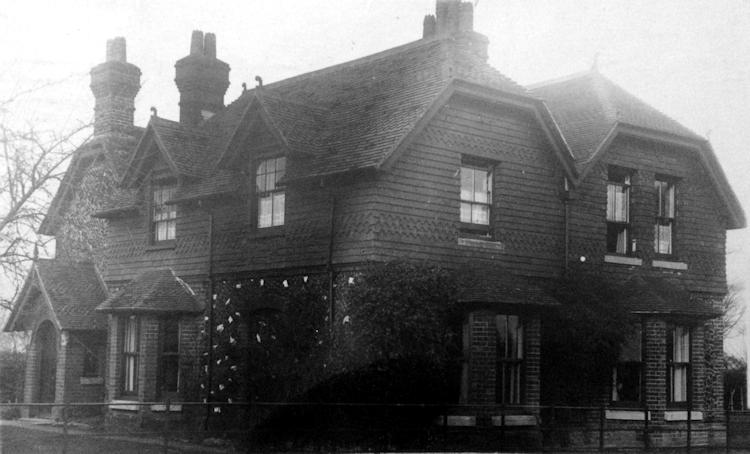
Above postcard showing King's Cottage, dated 1924, kindly sent by Ann
Elizabeth Goody.
However, the more 'racy' attractions of Brighton won over Walmer with the
Charrington's 2,000-strong workforce so Walmer was reduced to just a
bottling and storage plant for beer brewed elsewhere. Win Barrow has her own
ideas as to why this was:
'I think Charrington's bought the brewery with the intention of closing it
down, but nobody was made redundant when they took over, and it was some
time before the brewing section closed and Walmer became just a "bottling
department". We were all sacked and then had to "sign-on" again for our new
employer. They kept up the old traditions of Christmas parties for the
children, and even entered a float in Deal Regatta Carnival for several
years.
'After the brewery section was closed down, the offices which were across
the road were moved back into the main building, with the old beer cellar
then being used for bottling, with the entrance on the right down the
alleyway. Previous to that we had been in the building on the left through
the first gate. The old equipment was so ancient, it was not taken out and
re-used elsewhere, it was just left to rot. I remember we had a sports club
which had its cricket ground behind the offices of "The Old House" and we
had a Garden Party there one year.'
When the brewery was closed Charringtons still retained the site, which
included 'The Old House' and its large garden. In fact one of our local
cricket clubs used to play all their home matches on those grounds, as
ex-East Kent bus driver, Roger Saunders, recalls:
'About 1966/67 Pete White, together with two other East Kent drivers Bob
Young, John Brandon, and I were the founder members of the Barnes Close cc.
We played on the old Charrington's Brewery sports ground. There was still a
little pavilion where we all changed and my late father-in-law acted as an
umpire. It was a lovely setting for a cricket ground, all surrounded by
trees, but the only drawback was that with the railway line just over one of
the boundaries, a "six" might literally mean a "lost ball". We were very
disappointed when we were given notice to quit as the site was being put up
for sale.'
Upon the closure of the bottling department, the buildings were retained
as a storage facility for local deliveries, until the parent firm itself was
in turn taken over, and its assets stripped in the classic 'Jim Slater'
manner. After standing empty for several years, while negotiations were
being undertaken to redevelop the site, the work of demolishing the
buildings and clearing the site finally started in 1978.'
|
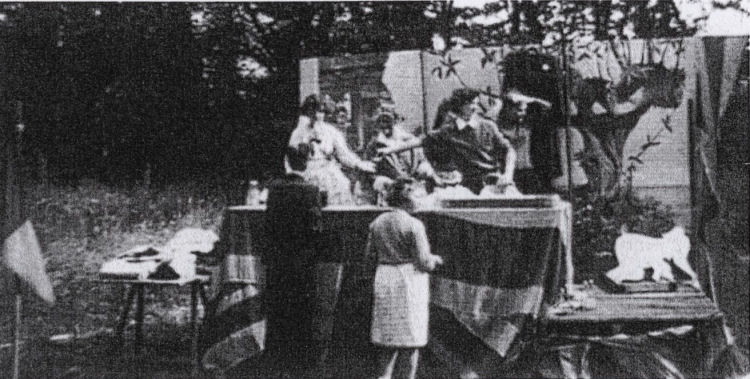
'Fun and Games' on the brewery sports field in the grounds of 'The Old
House', with Win Barrow and some of the other 'girls' running the jumble
stall. The Barnes Close Cricket Club used the pitch until given notice to
quit when the site was disposed of for redevelopment.
(Photo via Win Barrow) |
|
Tied houses
'The progress of the concern has been one of extremely rapid development,
for the firm is now a most extensive and very widespread business, not only
amongst "the trade" but with private families as well, in Deal, Walmer,
Dover, Sandwich, Ramsgate, Margate and throughout the towns and villages
extending to a radius of about fifteen miles from the brewery.'
('Deal and Walmer Illustrated Guide', 1897)
Before taking over the Deal Brewery of Hills & Co. Thompsons owned very few
tied houses outside the Deal & Walmer area. However, this acquisition added
substantially to their property holding list, 'with their 90 pubs painted
green and cream, from Margate to Folkestone, and inland as far as
Canterbury' (Dick Game). Amongst
the 'tied houses' where Thompson & Son's beers were sold were The
Dog Inn at Wingham, The
Crispin Inn, and The Ship at Sandwich. Another historic inn,
The Green Man at St Margaret's Bay had been associated with smuggling
activities, also being mentioned by the Baroness Orczy in her 'Scarlet
Pimpernel' novels. The Crispin Inn at Worth was another long-established
'house', reputedly owned by an 'ale wife' who was married to one of Henry
V's soldiers after their return from Agincourt. Henry's army was supplied
with locally brewed beer from the Deal and Walmer area, under the terms of
the Confederation of the Cinque Ports.
Although Thompsons had their own resident architect, they also commissioned
designs from outside practices. These included the rebuilding of the ancient
Swan Inn at the top of Queen Street, Deal, when this busy road junction was
being reorganised in 1937, and The Mill Inn on Mill Hill, Deal, built to
serve the residents on the new colliery workers' estate. Amongst the other
modern tied houses owned by the brewery were the Dane Valley Arms and the
King Edward the Seventh at Margate, both serving the expanding population of
that town. At Kingsdown, Thompson & Son had the monopoly, as they owned all
three public houses, The Rising Sun, The Old
Victory and The
Zetland Arms,
while the Five Bells at Ringwould was also the only 'house' in that village.
The Crown Inn at Eythorne had been an old posting and coaching house, where
in 1954 'the present tenant has been in possession for upward of forty-five
years', while The Five Bells at Eastry possessed 'a record of "Mine Hosts"
from 1695, numbering only fifteen' ('The Walmer Brewery Handbook').
The George and Dragon public house further down Dover Road at Upper Walmer
from the old brewery site was renamed The Thompson Bell while on the site of
The Old House is a housing development named Thompson Close. The Old House
by the brewery was demolished and its site is now a housing estate, while
the sports ground has now become a permanent caravan park. The cricket club
have now amalgamated with another local club, Deal Victoria, and have
acquired their own pitch.
|
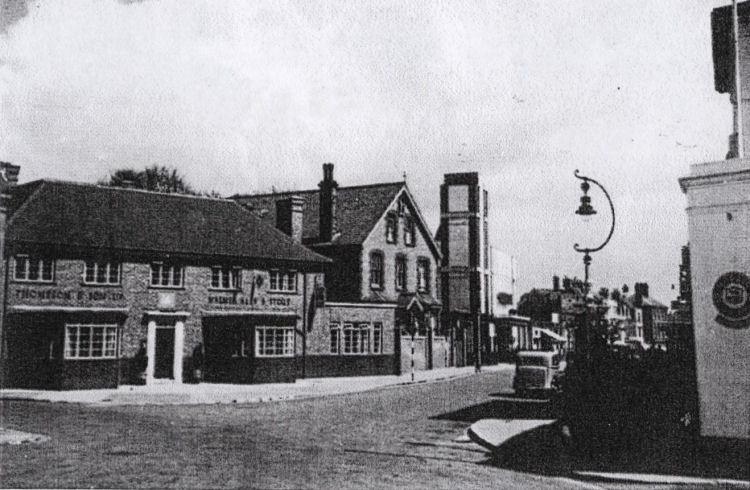
One of the new 'tied houses' owned by Thompson & Son was The "Swan Inn" which
had been rebuilt in 1937 when the upper part of Queen Street, Deal, was
widened. This building has now acquired the name The Hole in the Roof, but
appears virtually the same.
(Photo: W.L.A. Fenn) |
|
Codicil
Some of the buildings associated with the old brewery have been retained,
while some sympathetically designed housing has been erected on the site
where the former offices, maltings, bottling plant and the buildings around
the stable yard once stood. The roads have been named 'Down lands Close',
'Kingsland Gardens' and 'Newlands Drive', none of which, to my knowledge,
have any connection with the firm of Thompsons or their former employees. We
do have a 'Matthews Close', but that road is at the northern end of Deal,
almost as far away from the brewery site as one can reach!
|
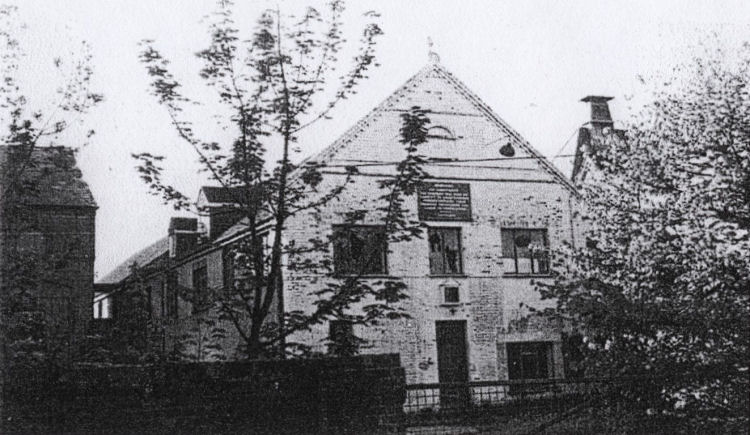
The dilapidated buildings of the old Walmer Brewery just prior to their
demolition in 1978. The notice on the gable end of the old office block
warns trespassers against entering the site, as it had remained empty and
neglected for several years after the brewery's final closure.
(Photo: David G Collyer) |
|
Acknowledgements
Mr Dick Game; Mrs Ivy Harrison, Mrs V.M. Hostie, Mrs Audrey West; 'The Deal
and Walmer Illustrated Guide' (1897); 'Health Resorts Assn Guide to Deal'
(1914); 'The Walmer Brewery, Kent' (Thompson & Son Ltd, 1950).
|
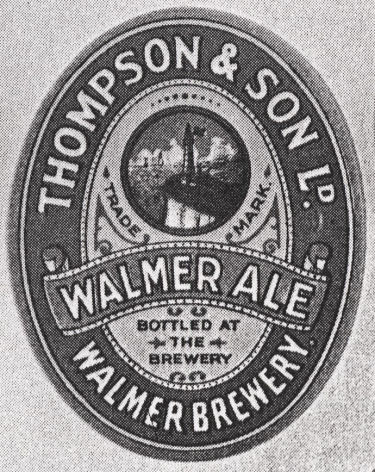 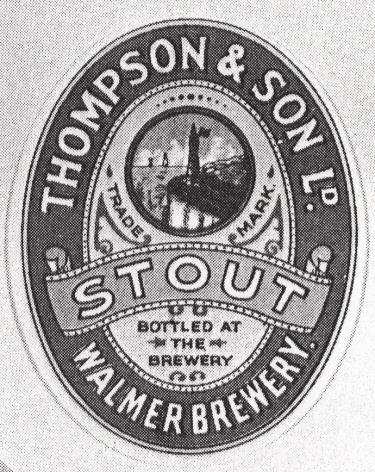
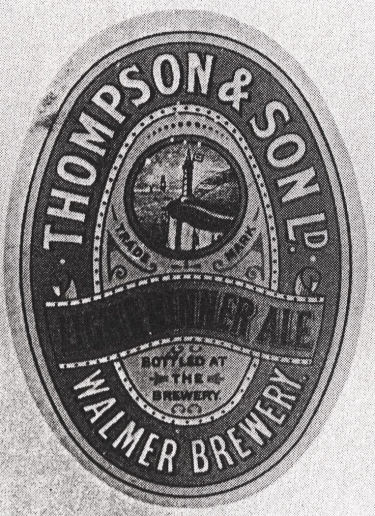

|
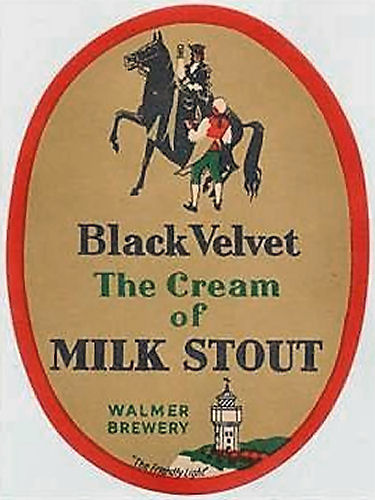 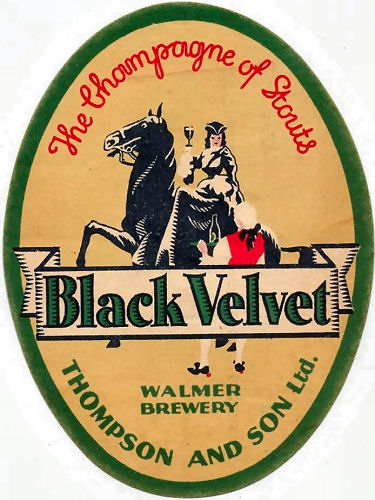 |
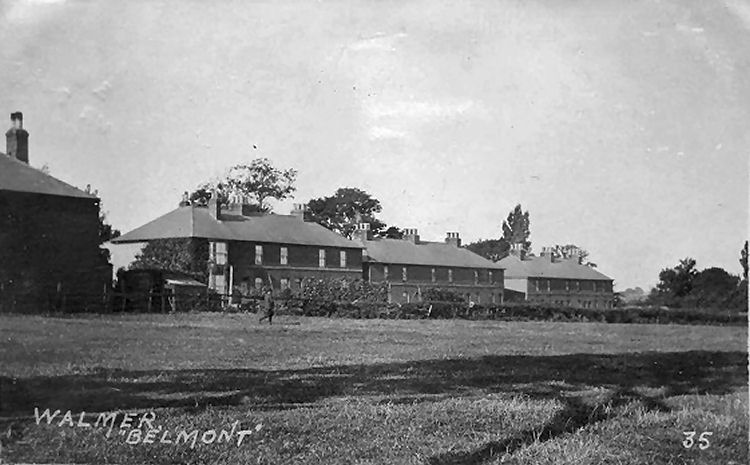
Above photo showing the brewery workers' tied houses in 1909. Kindly
sent by Rory Kehoe. |
|
From a local paper, 6 July 1855.
WALMER BREWERY.
ALTERATION OF FIRM.
Mr. Edmund Thompson respectfully informs his friends and the public,
that, being about to take his Son into Partnership, from and after the
Sixth of next Month the Business of the Brewery will be conducted in the
name of "THOMPSON and SON."
Walmer, 2nd June, 1855.
|
|
From the Deal, Walmer & Sandwich Telegram, 10 February 1858.
WALMER BREWERY
THOMPSON AND SON
Respectfully inform their friends and the Public, that their XXX ALE,
and EAST INDIA PALE ALE are now ready, and in splendid condition.
They recommend their Patrons to lose no time in ordering a supply for
the Summer consumption, as it's keeping Mild and Brilliant throughout
the year is secured by having it in before the weather gets warm.
T. and Son have much pleasure in adding they have reason to believe
that their Brewings of this Season will prove quite equal or superior to
any they had before, and which have obtained so high a character, and
extensive patronages. Other varieties of Ale and Porters of excellent
quality.
|
|
From the Deal, Walmer & Sandwich Telegram, 10 March 1858.
THOMPSON AND ANOTHER v. MARCH
The plaintiffs in this case were the respectable and well known
brewers of Walmer, and the defendant was a Farmer living at Sutton, near
Deal.
Mr. Moorilyan, Jun. of Sandwich appeared for the plaintiff and stated
that the claim for beer supplied to the defendants, and which had ranged
over a period of several years. The defendant did not appear, and his
Honour made an order for immediate payment with costs of Attorney and
Witness allowed.
|
|
From the Dover Express and East Kent News, 17 November,
1916.
DROWNED IN BEER
On Friday last, Mr. J. Turner, the brewer to Messrs. Thompson and
Son, Walmer Brewery, was found drowned in a vat of beer, into which he
had fallen.
|
|
From the Dover Express and East Kent News, 14 January, 1938.
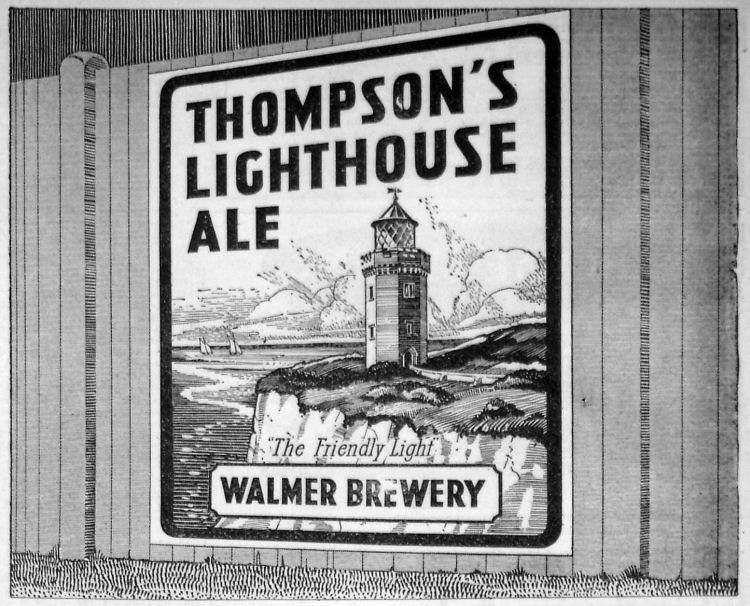
Above shows an advertisement for Thompson's Lighthouse Ale 1938. |
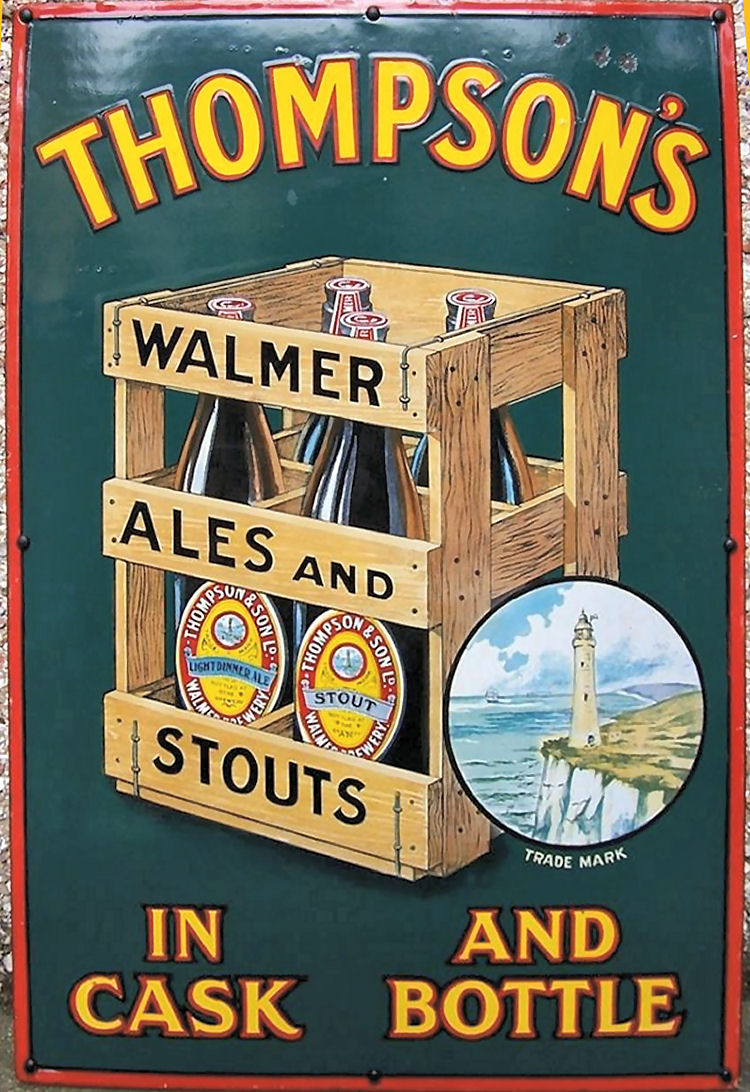
Above enamel advert, date unknown. |
|
From The Dover Mercury 28 January 1971
WALMER Brewery is due to close next year - this is the news announced by Charrington and Company among their plans for the redistribution of depots.
Public Relations Officer for Charrington and Company, Mr. H. W. Marden-Ranger,
told the East Kent Mercury that due to transport reasons it had been
decided to transfer the Walmer activities to a new depot to be built at
Faversham in 1972.
"We hope to be able to offer emplolment to our workers at Walmer at the
new depot at Faversham," he said.
"The Faversham depot will probably be bigger than the Walmer one, which
employs about 40 people."
A worker at the Walmer depot said: "Although we have been offered jobs at
Faversham there will be the problem of housing - for some of us it is a bit
late in our lives to pull up our roots and move to another town.
"Some workers might even retire early," he said.
The Walmer depot started as brewery over 150 years ago, it is not known
exactly when due to the loss of records in a fire.
Beer has not been brewed there since 1953 and bottling finished in 1964 -
since then it has been a distributing depot.
|
|
From The Adscene 25 November 1981
|
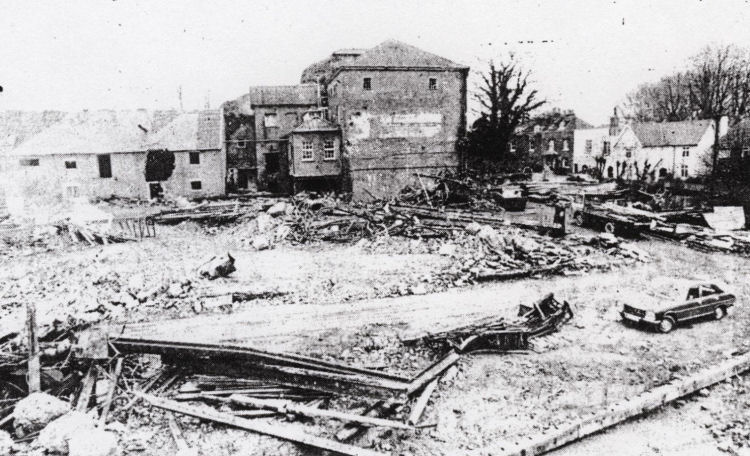 |
|
A once-important piece of local life is biting the dust at Walmer,
where the old town brewer is being demolished.
The Thompson Brewery
produced its last pint seven years ago (in 1974) and had been a major producer
during its 90-year existence.
Parts of the building, from iron fireplaces to chimney pots,
have been salvaged and attracted interest from people looking for
authentic building materials. Local pet shop owner, Mr. Pat McNicholas,
was at the site last week collecting "yellow stock" bricks. His High Street premises are in the conservation area and the
building work he plans has to be in keeping with the rest of the area. He says the brewery
bricks are ideal. |
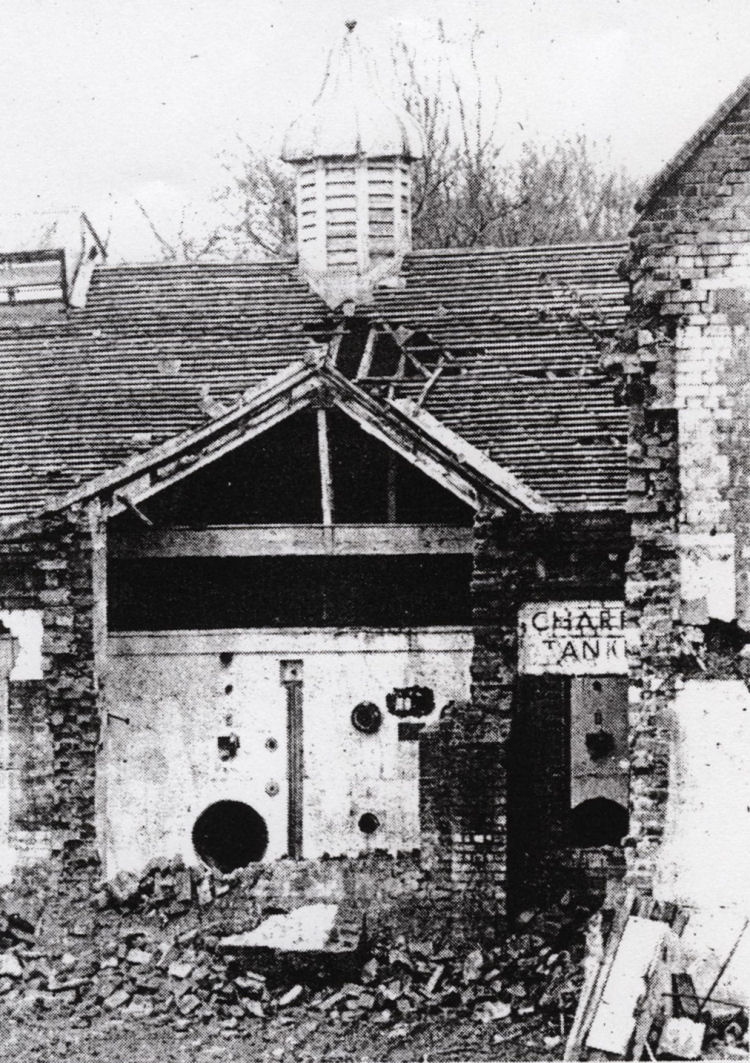 |
|
The belfry pictured above used to house the brewery bell, until production
stopped. The bell was removed and placed in the Dover Road public
house that bears its name. The Thompson
Bell.
Sadly, the bell was damaged in transit and does not now work.
|
|
From the Dover Express & East Kent News, 13 July 1973.
FLATS PLAN FOR WALMER BREWERY.
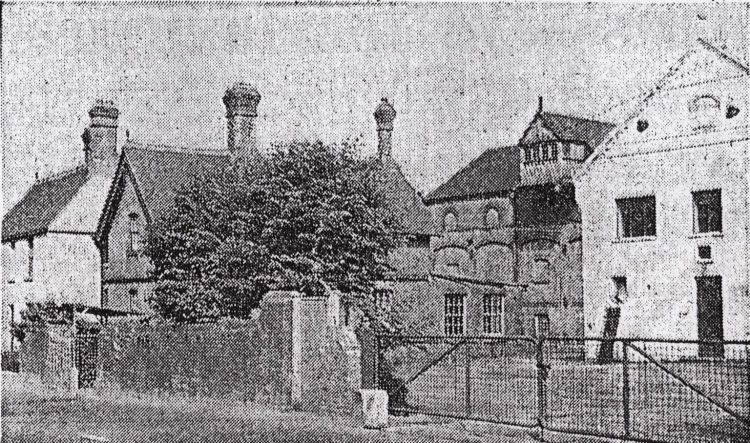
THE Licensed Victuallers National Homes have applied to Dover rural
councillors for outline planning permission to build 36 flatlets at Walmer for elderly people
connected with the
licensed trade.
The land in question is part of the southern end of
the site of The Brewery,
Dover Road.
|
|
From an email sent 2 December 2009.
I recently received the attached
article about Mr Albert Eli Whitlock who died whilst serving in the
First World War. After reading your website, I thought you may wish to
have a copy of the article as it mentions that, on return from the South
African (Boer) War (1899-1902), Mr Whitlock appears to have worked on
the clerical staff at Walmer Brewery until enlisting into the British
Army in October 1914. I would greatly appreciate any further information
that you may be able to provide about Mr Whitlock's career at the
Brewery and also any additional sources of information on this subject.
Yours faithfully,
Mr Carl Crane.
CLICK HERE for article.
|
|
From an email sent 21 July 2014.
Hello, yesterday I picked up a barometer and inscribed on it was a
plaque, for the retirement of Mr Harry Finnis, obviously he worked at
the brewery ,and I was just wondering if you knew of the family, the
date is 1964, it was being thrown away.
It was found in Cornwall.
I was just curious if you knew of the family thank you.
Tina Bettison.
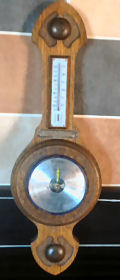
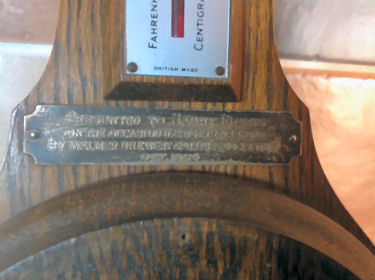
The plaque says the following:- Presented to Harry Finnis on the
occasion of his retirement by Walmer brewery sports and social club, Oct
1964. |
|
From an email sent 10 December 2014.
Regarding the barometer and Harry Finnis, I do remember him well. In
fact, I have in my possession a photograph of the Brewery's cricket
team, taken in the ?1950's, which includes Harry.
My father worked here from the age of 14 until retirement in 1971.
The house opposite the 'works' buildings, which became the offices some
time after the 2nd World War, was set in the most marvellous grounds.
These were a central cricket field, now the site of the caravan park,
surrounded on all sides by mighty old trees, under which there were
leafy walks through fairly dense shrubbery, small ponds and the
occasional decorative well. For us children, these grounds served as the
world's best playground. There were also a number of vegetable plots
between the northern boundary of the cricket field and the trees.
Further, behind the office building there were vegetable gardens and
greenhouses. The whole of this was tended by the gardener, a very
stooped, elderly chap called Frank Friend, who lived in the flint
cottage (now substantially extended) on the corner of Dover Road and
Thompson Close, and who would drop everything to mark out a court and
put up the net for us, as children, to play tennis. The brewery had a
very active cricket team, for which my father was a fast bowler, and
which played matches throughout east Kent. The cricket ground also
served as the venue for the brewery's annual sports day. Happy days,
indeed. If anyone reading this happens to have any pictures of these
lovely grounds and gardens I would very much like to see them.
Regards,
Tony Adams.
|
|
From an email received 22 March 2016. Hello,
My son found what appears to be a bottle stopper on Margate beach
(have attached photos).
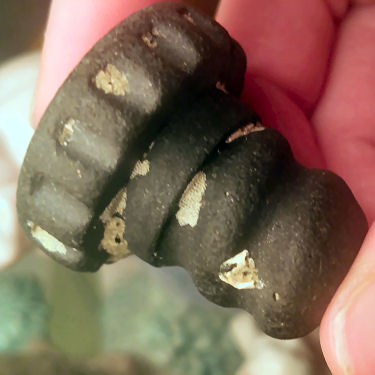 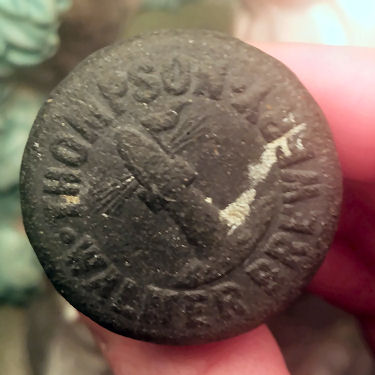
Lauren (mum to Brandon, age 9.)
|
|